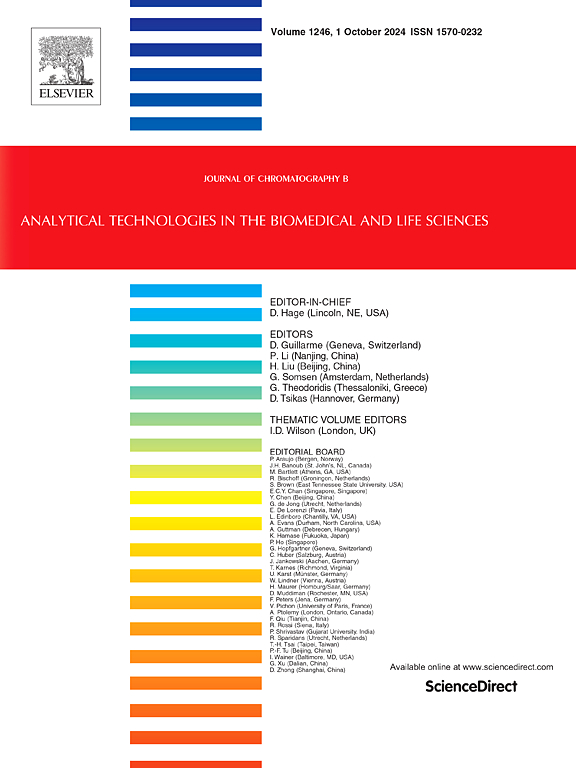HPLC-Q-TOF/MS研究腹腔注射条件下小檗碱在鲫鱼体内的残留及药动学行为
IF 2.8
3区 医学
Q2 BIOCHEMICAL RESEARCH METHODS
引用次数: 0
摘要
本文研究了人工环境条件下(温度:26±1.0℃;腹腔注射适当剂量为每体重2.0 mg/Kg的单次给药。此外,研究还利用高效液相色谱-四极杆飞行时间质谱(HPLC-Q-TOF/MS)技术研究了BBR在8种不同组织中的残留分布。药物暴露组共36头鲫鱼(每组平行3头),对照组3头。按指定时间(采样间隔24-96 h)取样,持续时间约1个月。根据不同组织中BBR的浓度绘制残留代谢药物浓度-时间曲线。在给药24 h后,各组织中的最大BBR浓度(Cmax)达到。Cmax的顺序为:muscle <;眼睛& lt;吉尔& lt;大脑& lt;肾脏& lt;intestine<肝脏& lt;胆汁。根据BBR在组织间的分布特点,肌肉、脑、眼和鳃组织中的药物浓度相对较低(约100 ~ 400 ng/g)。代谢迅速,24 ~ 200 h BBR残留量显著降低至数十ng/g。同时,胆汁、肾脏、肠道和肝脏BBR浓度显著升高(维持在1200 ~ 6000 ng/g)。随着药物停留时间的延长,浓度呈现波动和下降的特征。停药31 d后,采用非室室分析(non-compartmental analysis, NCA)软件,计算各药代动力学参数:最大观察浓度(Cmax)、终末半衰期(T1/2)、终末消除速率常数(λz)、分布体积(Vd/F)和总清除率(Cl/F)。本文的研究结果解释了鲫鱼体内BBR在排泄前的滞留,并可用于确定随时间变化的残留水平。本文章由计算机程序翻译,如有差异,请以英文原文为准。

Residual and pharmacokinetic behavior of berberine in Carassius auratus under intraperitoneal injection conditions by HPLC-Q-TOF/MS
The present study investigated the distribution characteristics of Berberine (BBR) in Carassius auratus under artificial environmental conditions (temperature: 26 ± 1.0 °C; continuous air pumping) following a single administration via intraperitoneal injection of an appropriate dosage of 2.0 mg/Kg per body weight. Additionally, studies have investigated the residual distribution of BBR in eight different tissues using high performance liquid chromatography-quadrupole-time of flight mass spectrometry (HPLC-Q-TOF/MS) technology. A total of 36 Carassius auratus (3 parallel samples per group) were in the drug-exposed group and 3 were in the control group. Carassius auratus were sampled at the indicated times (sampling interval: 24–96 h), lasting for approximately one month. The residual metabolic drug concentration-time curves were plotted according to the concentration of BBR in different tissues.
The maximum BBR concentrations (Cmax) in all tissues were achieved 24 h after the administration of the intraperitoneal injection. The order of the Cmax was: muscle < eye < gill < brain < kidney < intestine< liver < bile. According to the distribution characteristics of BBR between tissues, the drug concentrations in muscle, brain, eye, and gill tissues were relatively low (∼100 to >400 ng/g). Their metabolism was rapid, and BBR residue was significantly reduced to tens of ng/g from 24 to 200 h. Meanwhile, the bile, kidney, intestine, and liver contained significantly higher concentrations of BBR (maintained at 1200 to 6000 ng/g). The concentration shows a fluctuating and decreasing characteristic, with the drug remaining for a longer period. Following the 31 days BBR withdrawal period, the pharmacokinetic parameters of maximum observed concentration(Cmax), terminal half-life (T1/2), elimination rate constant during terminal phase (λz), the volume of distribution (Vd/F), and total body clearance (Cl/F) were calculated employing non-compartmental analysis (NCA) using the PK Solver software. The research results of the article explain the retention of BBR in Carassius auratus until excretion and can be used to determine residual levels over time.
求助全文
通过发布文献求助,成功后即可免费获取论文全文。
去求助
来源期刊

Journal of Chromatography B
医学-分析化学
CiteScore
5.60
自引率
3.30%
发文量
306
审稿时长
44 days
期刊介绍:
The Journal of Chromatography B publishes papers on developments in separation science relevant to biology and biomedical research including both fundamental advances and applications. Analytical techniques which may be considered include the various facets of chromatography, electrophoresis and related methods, affinity and immunoaffinity-based methodologies, hyphenated and other multi-dimensional techniques, and microanalytical approaches. The journal also considers articles reporting developments in sample preparation, detection techniques including mass spectrometry, and data handling and analysis.
Developments related to preparative separations for the isolation and purification of components of biological systems may be published, including chromatographic and electrophoretic methods, affinity separations, field flow fractionation and other preparative approaches.
Applications to the analysis of biological systems and samples will be considered when the analytical science contains a significant element of novelty, e.g. a new approach to the separation of a compound, novel combination of analytical techniques, or significantly improved analytical performance.
 求助内容:
求助内容: 应助结果提醒方式:
应助结果提醒方式:


